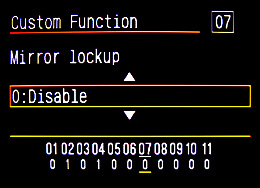 Mirror lockup is one of those little things you can do to get sharper photographs. Sure, by itself you may not see a big difference, but combine it with a few other little things, and you’ll begin to notice that extra sharpness.
Mirror lockup is one of those little things you can do to get sharper photographs. Sure, by itself you may not see a big difference, but combine it with a few other little things, and you’ll begin to notice that extra sharpness.
It makes sense to use mirror lockup when you have a somewhat controllable subject, like a landscape or wildflower. But, when you need to take shots quickly (like when you’re photographing wildlife or insects), then mirror lockup doesn’t make much sense because it only adds more time to your shots.
You should also avoid using mirror lockup when you’re photographing a bright light source (like the setting sun). After reading Canon’s white paper on the XTi, I’ve learned that this can actually damage the shutter curtains.
I looked at a few other camera manuals and saw the same warning: don’t use mirror lockup when photographing a bright light source. Some manuals even say turn it off for snowy landscapes!
I’ll admit that I’ve shot a few photos with the setting sun included, AND used mirror lockup.. and my camera is still safe, thank god! But, I think it’s a good idea to listen to the warnings of the camera manufacturers–at least the ones that make some sense 🙂
So, I do think it’s safe to use mirror lockup when photographing the sky AFTER sunset, but if you want to include the sun in your shot before it sets, I would only do it if it’s behind some clouds (to help block some of the intense light), and I would recommend disabling mirror lockup.
If you enjoyed this article, and would like to read more, please signup for free updates by email or RSS.
 About the Author: Steve Berardi is a naturalist, photographer, computer scientist, and founder of PhotoNaturalist. You can usually find him hiking in the beautiful mountains and deserts of Southern California.
About the Author: Steve Berardi is a naturalist, photographer, computer scientist, and founder of PhotoNaturalist. You can usually find him hiking in the beautiful mountains and deserts of Southern California.
Steve, Thanks for this info. I have noticed, like you did, that there is no whitepaper for the T1i, and having put my XTi away for safekeeping, I never thought to read it. There’s a saying in the computer geek community: RTFM, or Read The Fine Manual. You did, and passed along some valuable information.
All the best!
As I understand it the problem comes from the shutter curtains being painted black. If you lock up pointing into a very bright light source, say the sun reflecting off a car you may cause the black paint to vaporize (very small amounts) which creates a fine black smoke inside the camera that slowly coats everything.
Dave, thanks a lot for providing that info, it makes perfect sense. I searched for awhile trying to find out exactly how the shutter curtains could be damaged, so I’m glad the mystery has been solved 🙂
Useful advice!